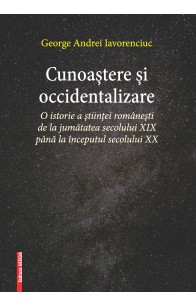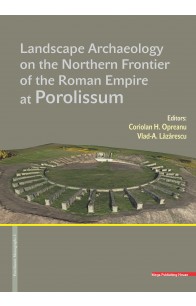Rezultate căutare pentru 'Vlad Andrei L��z��rescu'
Preț Normal: 55,00 LEI
Special Price 40,00 LEI
„Această cercetare are drept subiect analizarea felului în care ştiinţa s-a dezvoltat în România începând din cea de-a doua jumătate a secolului XIX şi până la începutul secolului XX. Prin «ştiinţă» înţelegem ştiinţele fizice şi naturale, aşa ca fizica, chimia, geologia sau biologia, deşi acestea nu au avut întotdeauna forma şi conţinutul pe care îl au astăzi. Aşadar, nu ne-am oprit, decât tangenţial, asupra ştiinţelor medicale (care beneficiază de o bibliografie relativ bogată în România), matematicii sau ştiinţelor sociale.” (din Introducere)
„The frontiers of the Roman Empire, over 5000 km long, stretch from the Atlantic coast of Scotland, along the Rhine and the Danube, also enclose the Banat region and Transylvania, then going down along the Oriental Carpathians to the Black Sea; from the southern coast of the Black Sea they continue towards the Near East until the Red Sea; then, in North Africa, they line the edge of the Sahara desert until the Atlantic coast of Morocco. Over this entire area, visible traces of fortifications, roads and settlements are still preserved, but numerous monuments still lay hidden underneath the earth. Despite the fact that the Roman frontiers crossed regions with different relief and climate, they constitute a whole in that they were designed to protect Roman territories. The research of these monuments and the preservation policy regarding them was and is unequal in the various presentday states on whose territory traces of the Roman frontier are to be found. Consequently, in the ‘80s of the 20th century, the idea of globally protecting the Roman frontiers, viewed as a unitary monument, was met. In 1987, Hadrian’s Wall in United Kingdom was declared a UNESCO monument. It was followed in 2005 by the German-Raetian sector, on which occasion the UNESCO committee decided to set up the ‘Frontiers of the Roman Empire’ site. (...)
This project through its complexity generated an interdisciplinary approach of the proposed subject stimulating such future attempts in the archaeological research field. By using the latest technical methods of non-destructive investigation the project did not damage the stratigraphy of the archaeological site obtaining instead a high amount of data otherwise time consuming judging from the archaeological excavations perspective contributing also to the preservation of the cultural heritage.” - Introduction
SUMMARY
Carmen Borbély & Petronia Popa Petrar, Foreword
I. Configurations of Posthumanist Thought
Horea Poenar, (Another) Year Zero: The Commons in a Posthuman Age
Rareș Moldovan, Authentes: a Shadow-Play or A Series of Observations in “Post” about Authenticity
Călina Părău, Thinking and Constructing Moments of Split
Attila Kovács, Anonymity and Spectral Existence in Urban Space
Marius Conkan, Mapping Literature: Geocritical Thinking and Posthumanism
Marie-Agnès Cathiard, De l’« imaginaïf » en prosthétique
Cosmina Moroșan, Peace and Technology. Michel Serres
II. Figurations of Posthuman Becoming
Christian Moraru, Crossing the Kafka Network: Schulz, Blecher, Foer, and the Repositioning of the Human
Giovanni Rotiroti, Subjectivations et désubjectivations post-humaines. Corps de langage et flux inconscients dans le matérialisme enchanté d’Urmuz et Gherasim Luca à partir de la pensée de Gilles Deleuze et Félix Guattari
Doru Pop, Replicant Theologies of the Early Robocene or The Covenant of Procreating Replicants, Cybernetic Fertility and Divine Androids
Alina Preda, “New Planets for Old”: A Posthumanist Ecocritical Approach to Jeanette Winterson’s Ustopia
Ruxandra Cesereanu, Lanark and Unthank – Posthuman Elements in Alasdair Gray’s Novel
Diana Melnic, Vlad Melnic, Shortcut to Posthumanism: Decentring Elements of the Gaming Experience
Kwasu D. Tembo, Among Them but Not One of Them: A Xenological Exploration of the Otherness and Power of DC Comics’ Superman
Nóra Máthé, “Are You Thor, the God of Hammers?” – Mixing the Posthuman and Old Norse Mythology in Thor: Ragnarok
Nicolae Andrei Szilagyi, The Human in the Context of a Posthuman World
Cristina Diamant, Archiva(b)l(e) Bodies and Cyber Afterlife in David Mitchell’s Cloud Atlas
Marius Viorel Pușcaș, From Narrative Art to Discourse. A Posthuman Approach in Firmin: Adventures of a Metropolitan Lowlife
III. Refiguring Past Trauma, Prefiguring an Apocalyptic Future
Corin Braga, Antiutopies apocalyptiques et posthumaines
Andrada Danilescu, Beyond the Human: Transhumanist Negotiations and Posthuman Instantiations in Aldoux Huxley’s Brave New World and David Mitchell’s Cloud Atlas
Dana Bizuleanu, Svetlana Alexievich and Posthuman Narratives
Anamaria Lupan, Marguerite Yourcenar et le post-humanisme
Dana Percec, The Canadian Tempest. Margaret Atwood and Shakespeare Retold as Hag-Seed
Aura Poenar, Necessary Monsters. Monstrous Narratives. Haunted Images of Our Time
Book Reviews
Preț Normal: 50,00 LEI
Special Price 40,00 LEI
CUPRINS
Dialectologie
GABRIEL BĂRDĂȘAN
Elemente lexicale moștenite sau creații interne ale istroromânei?
DUMITRU LOȘONȚI
Contribuții etimologice (II)
IULIA MĂRGĂRIT
Latinitatea „ascunsă” în lexicul graiurilor românești de la est de Bug, Ucraina
NICOLAE SARA MANDU
„Generația de vorbitori” și schimbarea în limbă
TEOFIL TEAHA
Un cuvânt moștenit din latină în graiul maramureșean actual
VASILE ȚÂRA
Un fenomen sintactic dialectal
Fonetică
FERNANDO SÁNCHEZ MIRET
Câteva observaţii asupra diftongării metafonice în limba română
VLADIMIR ZAGAEVSCHI
Reflecţii privind definiţia diftongilor şi statutul semivocalelor [i] şi [u] în limba română
Gramatică
SERGIU DRINCU
Punctuația lui însă
ȘTEFAN GĂITĂNARU
Complementul prepozițional în limba română veche
G. G. NEAMȚU
Câteva observații privind sintagmele posesive/ genitivale cu „al” + în limba română
Istoria limbii române
GHEORGHE CHIVU
Terminologia părților corpului în scrieri vechi românești
MARCU MIHAIL DELEANU
 și Î în trei înscrisuri bănățene din 1902
Jurnalism
ILIE RAD
Precursorii presei românești
Lexicologie
ANA-MARIA BOTNARU
Doi termeni generici de origine latină: pădure şi arbore
TRAIAN DIACONESCU
Antim Ivireanul. Structura retorică şi strategia argumentativă în Didahii
IONEL FUNERIU
Naturalia non sunt turpia
ADRIANA STOICHIȚOIU ICHIM
Cuvinte „la modă” în discursul politico-publicistic actual
EMIL SUCIU
„Turcisme” în Transilvania
AIDA TODI
Trecerea de la vorbirea directă la vorbirea indirectă şi stimularea creativităţii lingvistice
IOANA VINTILĂ-RĂDULESCU
Adjective referitoare la numele statelor lumii
Limba și literatura latină, filozofie și cultură clasică
TRAIAN DIACONESCU
Concepția despre timp în tragediile lui Sofocle
TRAIAN DIACONESCU
Conceptul de verosimil în retorica și poetica latină
LIVIU FRANGA
Lirismul colectiv și formele sale în Antichitatea clasică. Lirismul colectiv laic
MARIANA FRANGA
Debutul lirismului individual la Roma. Primele forme ale poeziei lirice latine culte: lirismul dramatic
DAN NEGRESCU
O cale către Sfinții Părinți
Lingvistică și filologie romanică
IULIA BARBU
Adaugă la lista de favorite
Adăugare la Comparație
Țara Năsăudului este una dintre micro-regiunile României care s-a bucurat de o atenţie ştiinţifică aparte, nu doar din partea istoricilor, ci dinspre întregul spectru al ştiinţelor umaniste şi sociale. Bibliografiile istorice ale României au acumulat, volum de volum, numeroase titluri dedicate temei: fie cărţi, fie studii şi articole provenite atât din periodice ştiinţifice locale, cât şi din principalele reviste de istorie din centrele universitare sau din diverse volume de studii. Această valoroasă literatură ştiinţifică a devenit în timp tot mai amplă, solicitând cercetătorilor, şi mai ales cercetătorilor debutanţi, un efort consistent de documentare bibliografică.
Organizarea şi activitatea Regimentului 17 (2 românesc) de graniţă pe teritoriul năsăudean au legat acest spaţiu de ansamblul istoriei Monarhiei habsburgice într-un mod mai intim şi pe alocuri chiar mai spectaculos decât alte regiuni locuite de români. (din „Introducere”)







